Disaster at Chocques Airfield, 12 March 1915
- Home
- World War I Articles
- Disaster at Chocques Airfield, 12 March 1915
When the Royal Flying Corps (RFC) arrived in France in mid-August 1914 it effectively had no offensive capability, however, the situation soon saw weapons being dropped on the enemy. Some were primitive in the extreme, such as the flechettes, which were nothing more than large darts for dropping on troop concentrations, and multi-pronged caltrops for injuring cavalry or transport horse hooves.
Soon the need for more effective weapons was recognised and explosive devices such as rifle grenades were dropped on the enemy. One major handicap was the inability of the aircraft of the day to carry any load much above that of the weight of the crew, and it often became a choice of carrying an observer or bombs, but not both.
By early 1915 the RFC was using Melinite bombs which were converted French artillery shells with a nose striker. They were carried in locally manufactured tubes attached to the fuselage and retained by a pin that stopped it dropping out of the bottom of the tube. The bomb itself had no other safety devices and the pilot would release it by reaching over the side of the cockpit and pulling out the pin.
On 12 March 1915 at 5 p.m. Melinite bombs were being loaded onto a 3 Squadron aircraft at Gonneham (also known as Chocques) airfield. James McCudden recorded that he ‘had just seen Captain Conran and Mr Pinney off on a Morane, and on my way back to my flight shed passed Captain Cholmondeley and his Morane outside “A” Flight sheds. The machine was then being loaded with six of the Melinite bombs... I had just got back to my flight sheds when “crump-crump” came two explosions in quick succession, and I distinctly felt the displacement of air... I turned round and saw Captain Cholmondeley’s aircraft on fire from wing-tip to wing-tip’.
McCudden, along with others, ran to the scene to render assistance and he recorded that ‘Lieutenants Pretyman, Blackburn, Cleaver and Sergeant Burns were the leaders of the party’. They found a dozen or so men lying around the aircraft ‘all badly mutilated’. With the aircraft on fire and more bombs still in place they worked quickly to remove the casualties from the danger area.
When Major Salmond arrived on the scene he ordered everyone clear, but stayed by the wreck in what McCudden regarded as ‘a splendid example of coolness that still further increased our great respect of our Commanding Officer’. Salmond returned to the wreck first thing the following morning and personally removed the remaining bombs and made the scene safe.
Although McCudden records that eleven men were killed and one wounded, other sources give different numbers [1].
The eight RFC fatalities are buried in Choques Military Cemetery. They are:-
Captain Reginald Cholmondeley, was born in Hertfordshire in September 1889, and later educated at Eton. He first enlisted into the Rifle Brigade and as a Lieutenant learnt to fly at the Grahame-White School, Hendon, being awarded Royal Aero Club (RAC) Aviators Certificate No. 271 on 13 August 1912. Attached to the RFC, he was reported to be a popular member of the squadron and regarded as one of their best pilots, being Mentioned in Dispatches in February 1915. Grave Ref: I.B.10

Above: Reginald Cholmondely. IWM: Lives of the First World War Image
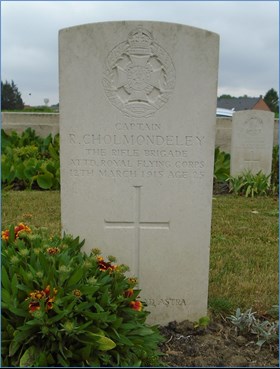
Above: Captain Reginald Cholmondeley’s grave. Photo - Derek Bird
194, Flight Sergeant, Joseph Costigan, was born in London in 1889. He had originally been a gunner in the Royal Field Artillery but transferred to became an early member of the RFC. Hehad arrived in France with 3 Squadron on 13 August 1914. Grave Ref: I.A.37.
534, Air Mechanic 1st Class, Wilfred Barker, was born in Derby in 1895. He was a pre-war recruit who enlisted directly into the RFC in January 1913. One reference indicates he was discharged in April 1914 [2].He was, however, back serving with the RFC in France in the August. Grave Ref: I.A.41. (Collective grave).
582, Corporal, Oliver Bowyer, was born in Bracknell, Berkshire in 1892. He joined the RFC on 1 February 1913 and had served in France since 13 August 1914. Grave Ref: I.A.41 (Collective grave).
589, Air Mechanic 1st Class, George Cook, was born in Windsor, Berkshire in 1895. He enlisted in 1913 and had served with 3 Squadron in France since 13 August 1914. Grave Ref: I.A.36.
872, Air Mechanic 1st Class, Albert Morgan, was born at Farnborough, Hampshire, in 1894. He had initially served in the King’s Royal Rifle Corps, and transferred to the RFC in April 1913. Grave Ref: I.A.41 (Collective grave).
1192, Air Mechanic 1st Class, Arthur Cuff, was born in Bournemouth in 1894. He joined the RFC in April 1914 and went to France with 3 Squadron on 13 August 1914. Grave Ref: I.A.38.
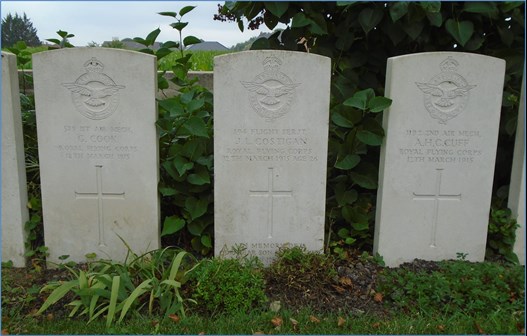
Above: The graves of 1st Air Mechanic Cook, Flight Sergeant Costigan and 2nd Air Mechanic Cuff. Photo - Derek Bird.
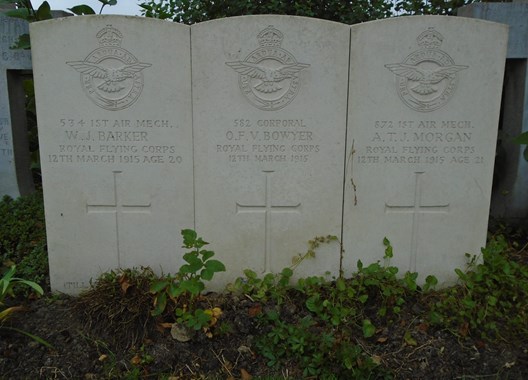
Above: The collective grave of 1st Air Mechanic Barker, Corporal Bowyer and 1st Air Mechanic Morgan. Photo - Derek Bird.
1934, Air Mechanic 1st Class, Samuel Tugwell, was born in Eastbourne, Sussex, in 1894, and was an early wartime recruit. Grave Ref: I.A.43.
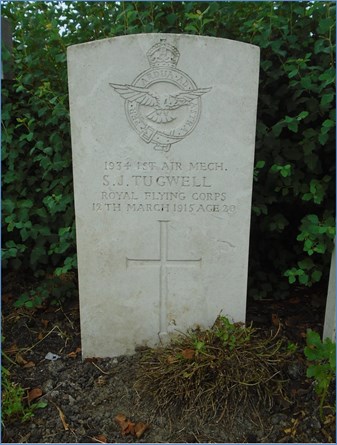
Above: 1st Air Mechanic Tugwell’s grave. Photo - Derek Bird.
Injured and rescued from the scene was 1171, Air Mechanic 2nd Class, Stanley Bird, who joined the RFC in March 1914 and had served with 3 Squadron in France since August 1914. He recovered from his injuries and continued to serve, later being promoted to Sergeant (Driver MT) in September 1916 and he was still serving in that rank and trade in April 1918 when the Royal Air Force was formed.
The cause of the accident was not conclusively proved, however, it is most likely that a securing pin was not fully in place, or became dislodged as a bomb was being loaded. Another possibility is that a bomb was accidentally dropped during loading. No matter, without safety devices on the nose fuse, any slight mishap was likely to end in disaster. Needless to say that the subsequent development of bombs included safety devices in the design.
Whilst the eight RFC men are easily accounted for what about the other three (or four) dead reported in later accounts? Well, Chocques Military Cemetery may provide some clues. Interspersed amongst the seven RFC graves (Captain Cholmondely is buried in another row) are three others, two men from the Army Service Corps (ASC) and one from the Coldstream Guards.
25078, Lance Corporal, Thomas Baxter, and 29981, Driver, William Challis, belonged to the 15th Depot Unit of Supply, ASC, and it is possible that they were responsible for delivering the bombs to the squadron and were interested spectators as they were loaded.
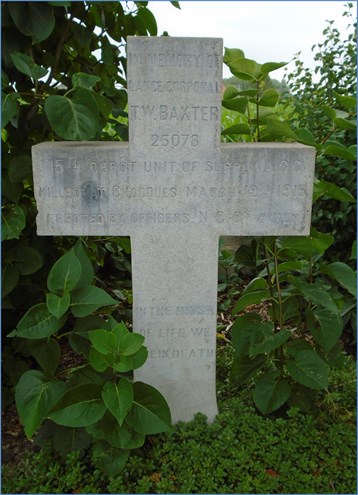
Above: Lance Corporal Baxter, ASC, headstone. Photo - Derek Bird.
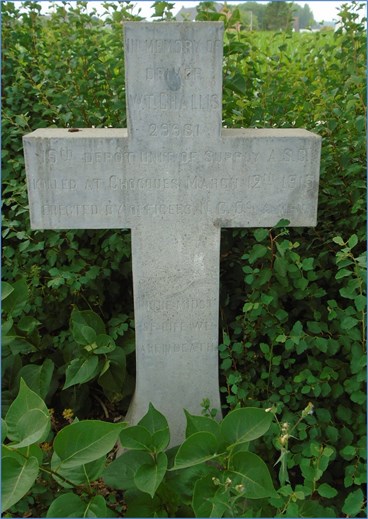
Above: Driver Challis, ASC, headstone. Photo - Derek Bird.
11533, Guardsman, Thomas Sharples, 1st Battalion, Coldstream Guards, has a headstone in amongst those of the airmen. The Coldstream Guards were in action at Richebourg l’Avoue, about six miles to the north-east, and it is most likely that he was wounded and evacuated to the Casualty Clearing Station at Chocques where he died -the placing of his grave just being due to there being one available amongst the RFC men on the day of burial.
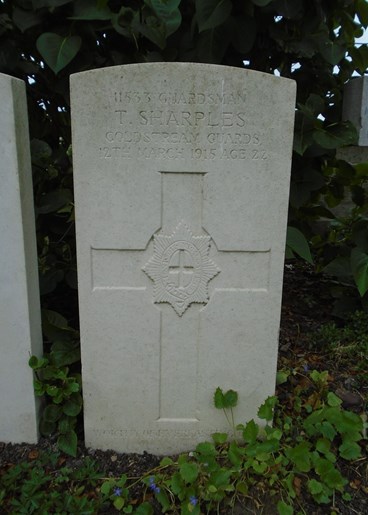
Above: Guardsman Sharples’ headstone. Photo - Derek Bird.
The only other headstone in Chocques with the date of 12 April is that of 9693, Private, Charles Whistler, 2nd Battalion, East Surry Regiment, and he is buried at the end of the row of RFC men. His battalion was in action around that date at Spanbroekmolen, near Ypres, and, while they had about 40 men killed, those with known graves are all buried either in that vicinity, or at one of the hospitals on the coast at Boulogne or Wimereux. Quite why Charles Whistler is buried so far from the expected medical chain of evacuation for a casualty from near Ypres is unknown.
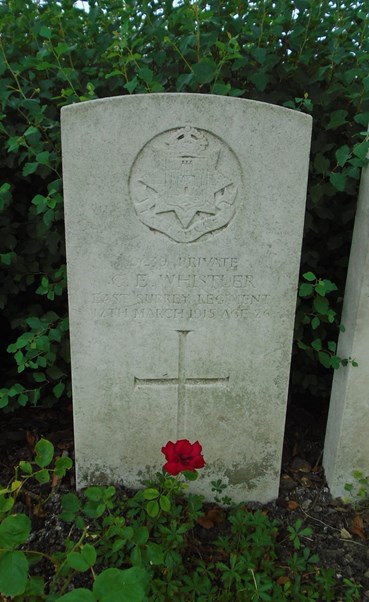
Above: Private Whistler’s headstone. Photo - Derek Bird
So, assuming the two ASC men were killed in the bomb explosion, there appear to be 10 victims buried in Chocques; the two infantrymen mentioned would appear to have simply been buried in available graves that were coincidentally amongst the RFC men who died on the same day.
Some of those mentioned went on to have distinguished careers. Major John Salmond was born in 1881 and joined the army in 1900. After graduating from Sandhurst he was commissioned into the King’s Own Royal Lancaster Regiment and saw service in the final stages of the Boer War. He learnt to fly at the Central Flying School and gained his RAC certificate (No. 272)on 13 August 1912. He rose through the ranks of the RFC and by January 1918 he was General Officer Commanding the RFC in the Field, having taken over from Trenchard. Post-war he remained in the RAF and was appointed Chief of the Air Staff in January 1930, and Marshal of the Royal Air Force in January 1933. During WW2 he served in a number of posts before ill-health forced his retirement in 1943. He continued to attend RAF events until his death at the age of 86 in 1968.
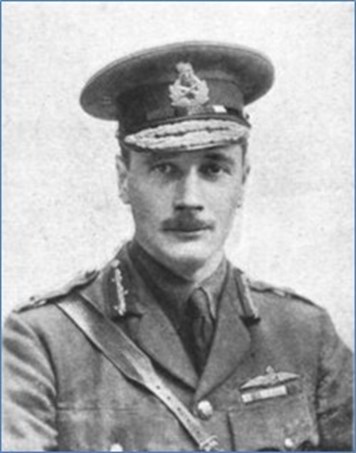
Above: John Salmond. IWM Lives of the First World War image
Lieutenant George Pretyman was born in India in 1891 and originally served with the Somerset Light Infantry. He obtained his RAC Certificate (No. 341) on 22 October 1912. On 26 August 1914 Pretyman began the RFC’s bombing campaign when he dropped a single bomb from a Bleriot aircraft onto enemy transport near Cambari. His engine was hit by enemy fire and he was forced to land and set fire to his aircraft. He and his observer, Major Boyd-Moss, then joined some French cavalry heading to Arras, before eventually rejoining the squadron. On 15 September 1914 he undertook the first ever photo reconnaissance mission. He was awarded the DSO and twice Mentioned in Despatches and commanded 1 Squadron in late 1915. He survived the war.
Lieutenant Harold Blackburn was born in Gloucestershire in 1879. A pre-war aviation pioneer he received his RAC Certificate (No. 79) on 9 May 1911. He piloted the first scheduled airline service in the UK, between Leeds and Bradford on 22 July 1914 as part of that year’s Yorkshire Show. He joined the RFC at the outbreak of war and after serving on 3 Squadron in France, he commanded ‘C’ Flight of 14 Squadron then forming up in England before seeing service in the Sinai Desert and Palestine. He later commanded 22 Training Squadron at Aboukir, Egypt, before returning to France as a Lieutenant-Colonel on the staff of GHQ. He was awarded the Military Cross and the Air Force Cross, and retired from the RAF as a Wing Commander in August 1929.
Lieutenant C. Cleaver continued to fly as an observer throughout 1915. Along with his pilot, Captain M. Barratt, he shared a victory on 11 October 1915 with two crews from 2 Squadron when they shot down an Albatros near Noyelles-Les-Vermelles. It is thought that he retrained as a pilot and returned to France in 1916 and was twice wounded by rifle fire. He appears to have survived the war.
100, Sergeant, William Burns, came from London, and was a Corporal when 3 Squadron went to France in August 1914. He died on 6 October 1915, aged 27, of shrapnel wounds received during the Battle of Loos when he was in a shell hole near the front line signalling with a lamp to squadron aircraft overhead. By this time he had been promoted to Flight Sergeant. He is buried in Etaples Military Cemetery (Grave Ref: III.C.8A).
James McCuddenis the best known of the men involved in the incident at Gonneham. He had transferred from the Royal Engineers, which he had joined as a Boy Bugler, in 1910, to the RFC in April 1913. He made a number of flights as a passenger with his elder brother (Sergeant, William McCudden, an instructor who was killed in a flying accident in May 1915; a younger brother, John, was shot down and killed in March 1918) and other pilots pre-war. Early in the war he flew a number of times as observer / gunner (armed with just a rifle) before being promoted to Sergeant shortly after this incident. By July 1915 he was formally recognised as an observer. He returned to the UK in early 1916 and trained to be a pilot, obtaining his RAC Certificate (No. 2745) on 16 April and was retained as an instructor, despite only eight solo flying hours at that stage! He went back to France (20 Squadron flying FE2Bs) in July 1916 before a transfer to the single-seat ‘scout’ DH2s of 29 Squadron a month later.
He claimed his first victory on 9 September, and another four by mid-February 1917. He returned to the UK for a ‘rest’ as an instructor, before returning to France in June 1917 and joined 66 Squadron (Sopwith Pups) scoring a single victory before being posted to 56 Squadron flying the SE5, a type on which he would claim 50 victories between August1917and February 1918. He returned to the UK again in March 1918 and would not see action again. He was awarded the Victoria Cross and promoted to major in early 1918. He was given command of 60 Squadron flew a new SE5 to France on 9 July and, uncertain of the exact location of the German lines, he saw what he thought was 60 Squadron’s airfield at Boffles, but saw it was empty. He then flew on to Aix-le-Chateaux to get directions. After a short stop on the ground he took off but within seconds the aircraft climbed steeply before rolling and nose-diving into the ground.
McCudden was taken to the 21st Field Ambulance where he died of a fractured skull at about 8 p.m. It is believed that a faulty carburettor was the cause of a loss of power at a critical point shortly after getting airborne. James McCudden was awarded the VC, DSO and Bar, MC and Bar, MM and French Croix de Guerre, and was credited with 57 victories; he was still only 23 years old. It is interesting to think that, had he been a few seconds later walking back to his flight shed on 12 March 1915, he could have been killed in the explosion and never had the chance to become one of the RFC / RAF’s highest scoring pilots. He is buried in Wavans British Cemetery (Grave Ref: B.10).
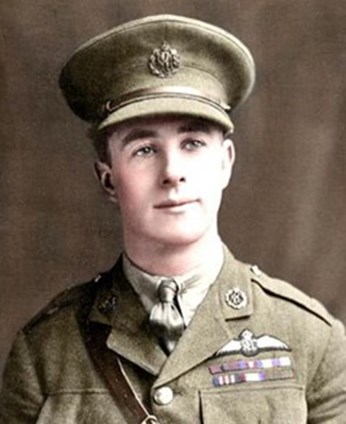
Above: Major James McCudden VC. IWM Lives of the First World War image
Article contributed by Derek Bird
References
[1] James McCudden, Flying Fury: Five Years in the Royal Flying Corps; Ralph Barker, The Royal Flying Corps in France: From Mons to the Somme; I. McInnes & J.V. Webb, A Contemptible Little Flying Corps.
[2] I. McInnes & J.V. Webb, A Contemptible Little Flying Corps





